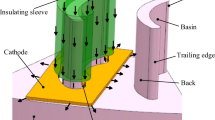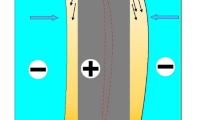Abstract
Aiming to solve the problems of the low electrolyte flow rate at leading edge and trailing edge and poor uniformity of the end clearance flow field during the electrochemical machining (ECM) of diffuser blades, a gap flow field simulation model was established by designing three liquid-increasing channels at the leading edge and the trailing edge of the cathode. The simulation results indicate that the liquid-increasing hole channel (LIHC) with an outlet area S of 1.5 mm2 and a distance L from channel center to edge point of 3.2 mm achieves optimal performance. In addition, the experiment results show that the optimized cathode with liquid-increasing hole channel (LIHC) significantly improves the machining efficiency, accuracy, and surface quality. Specifically, the feed speed increased from 0.25 mm/min to 0.43 mm/min, the taper decreased from 4.02° to 2.45°, the surface roughness value of the blade back reduced from 1.146 to 0.802 µm. Moreover, the roughness of the blade basin decreased from 0.961 to 0.708 µm, and the roughness of the hub reduced from 0.179 to 0.119 µm. The results prove the effectiveness of the proposed method and can be used for ECM of other complex structures with poor flow field uniformity.










Similar content being viewed by others
Availability of data and materials
We confirm that the data and materials supporting the findings of this study are available within the article.
Code availability
Not applicable.
References
Benichou E, Trébinjac I (2016) Comparison of steady and unsteady flows in a transonic radial vaned diffuser. J Turbomach 138(12):121002–1–10
Marsan A, Trébinjac I, Coste S, Leroy G (2013) Temporal behaviour of a corner separation in a radial vaned diffuser of a centrifugal compressor operating near surge. J Therm Sci 22(6):555–564
González-Barrio H, Calleja-Ochoa A, Lamikiz A, López de Lacalle LN (2020) Manufacturing processes of integral blade rotors for turbomachinery. Processes and New Approaches Applied Sciences 10(9):3063
Klocke F, Zeis M, Klink A, Veselovac D (2012) Technological and economical comparison of roughing strategies via milling, EDM and ECM for titanium- and nickel-based blisks. Proc CIRP 2:98–101
Musfirah HA, Ghani JA, Haron CHC (2017) Tool wear and surface integrity of inconel 718 in dry and cryogenic coolant at high cutting speed. Wear 376–377:125–133
Xu JK, Ren WF, Lian ZX, Yu P, Yu HD (2020) A review: development of the maskless localized electrochemical deposition technology. Int J Adv Manuf Technol 110(2)
Klocke F, Zeis M, Klink A, Veselovac D (2013) Experimental research on the electrochemical machining of modern titanium- and nickel-based alloys for aero engine components. Procedia CIRP 6:368–372
Davydov AD, Kabanova TB, Volgin VM (2017) Electrochemical machining of titanium. Review Russian Journal of Electrochemistry 53(9):941–965
Lohrengel MM, Rataj KP, Münninghoff T (2016) Electrochemical machining-mechanisms of anodic dissolution. Electrochim Acta 201:348–353
Holstein N, Krauss W, Konys J (2011) Development of novel tungsten processing technologies for electrochemical machining (ECM) of plasma facing components. Fusion Eng Des 86(9–11):1611–1615
Liu GX, Zhang YJ, Natsu W (2019) Influence of electrolyte flow mode on characteristics of electrochemical machining with electrolyte suction tool. Int J Mach Tools Manuf 142:66–75
Rajurkar KP, Sundaram MM, Malshe AP (2013) Review of electrochemical and electrodischarge machining. Procedia CIRP 6:13–26
Burger M, Koll L, Werner EA, Platz A (2012) Electrochemical machining characteristics and resulting surface quality of the nickel-base single-crystalline material LEK94. J Manuf Process 14(1):62–70
McGeough JA (1974) Principles of electrochemical machining. Chapman and Hall, London
Deconinck D, Damme SV, Albu C, Hotoiu L, Deconinck J (2011) Study of the effects of heat removal on the copying accuracy of the electrochemical machining process. Electrochim Acta 56(16):5642–5649
Qu NS, Hu Y, Zhu D, Xu ZY (2014) Electrochemical machining of blisk channels with progressive pressure electrolyte flow. Mater Manuf Processes 29:572–578
Xu ZY, Sun LY, Hu Y, Zhang JC (2013) Flow field design and experimental investigation of electrochemical machining on blisk cascade passage. Int J Adv Manuf Technol 71(1–4):459–469
Tang L, Yang F, Zhu QL, Gan WM (2015) Electrochemical machining flow field simulation and experimental verification for irregular vortex paths of a closed integer impeller. Int J Adv Manuf Technol 83(1–4):275–283
Wang Y, Xu Z, Liu J, Zhang A, Xu ZL, Meng DM, Zhao JB (2020) Study on flow field of electrochemical machining for large size blade. International Journal of Mechanical Sciences 190:106018
Liu Y, Qu NS (2020) Improvements to machining surface quality by controlling the flow direction of electrolyte during electrochemical sinking and milling of titanium alloy. Science China(Technological Sciences) v.63(12):234–244
Lei GP, Zhu D, Li JB (2021) Optimization of flow field in electrochemical trepanning of integral cascades (Ti6Al4V). Chinese Journal of Aeronautics (13)
Zhu D, Gu ZZ, Xue TY, Liu A (2017) Simulation and experimental investigation on a dynamic lateral flow mode in trepanning electrochemical machining. Chin J Aeronaut 30(4):1624–1630
Fujisawa T, Inaba K, Yamamoto M, Kato D (2008) Multiphysics simulation of electrochemical machining process for three-dimensional compressor blade. J Fluids Eng 130(8):081602–1–7
Analytis GT (2001) Implementation and assessment of the renormalization group (RNG), quadratic and cubic non-linear eddy viscosity k-ε models in GOTHIC. Nucl Eng Des 210:177–191
Koutsourakis N, Bartzis JG, Markatos NC (2012) Evaluation of Reynolds stress, k-ε and RNG k-ε turbulence models in street canyon flows using various experimental datasets. Environ Fluid Mech 12:379–403
Funding
This work was supported by the National Natural Science Foundation of China (U19A20103); The Fund for Jilin Province Scientific and Technological Development Program (No. Z20190101005JH); The Fund for The Central Government Guides Local Science and Technology Development Funds to the special basic research of Jilin Province (No. 202002039JC).
Author information
Authors and Affiliations
Contributions
Jinkai Xu and Wanfei Ren were responsible for substantive revision; Jin Tao drafted the manuscript and performed the experiments; Kun Tian assisted in the experiment; Xiaoqing Sun performed the interpretation of the data; Huadong Yu contributed to the design of the work.
Corresponding authors
Ethics declarations
Ethical approval
Not applicable.
Consent to participate
Not applicable.
Consent for publication
Not applicable.
Competing interests
The authors declare no competing interests.
Additional information
Publisher's Note
Springer Nature remains neutral with regard to jurisdictional claims in published maps and institutional affiliations.
Rights and permissions
About this article
Cite this article
Xu, J., Tao, J., Ren, W. et al. Simulation and experiment research on liquid channel of diffuser blade by electrochemical machining. Int J Adv Manuf Technol 119, 6045–6056 (2022). https://doi.org/10.1007/s00170-021-08497-y
Received:
Accepted:
Published:
Issue Date:
DOI: https://doi.org/10.1007/s00170-021-08497-y




